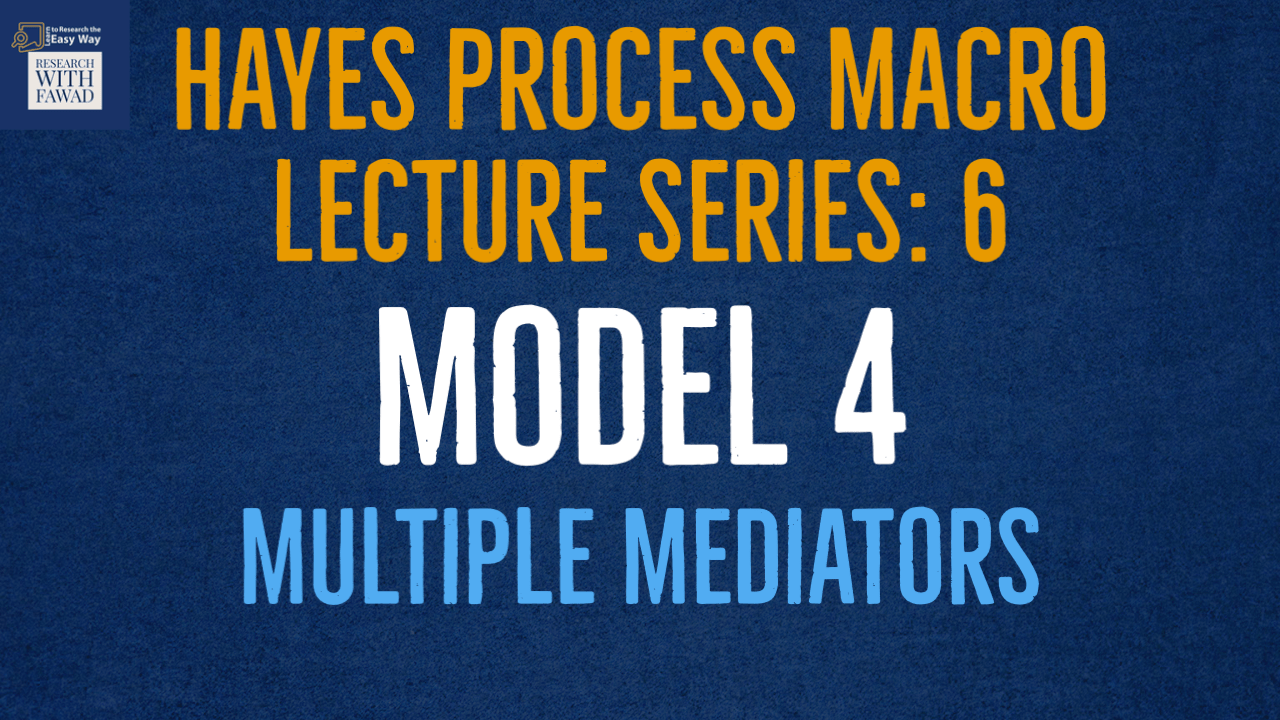Hayes Process Macro - Model 4 - Multiple Mediation Analysis

Hayes Process Macro - Lecture Series
The tutorial will guide on Model 4 of the Hayes Process Macro for Mediation Analysis.
Introduction
- Up to this point, we have focused on how to perform moderation analysis using the Process Macro.
- Let’s now examine how the influence between two constructs may take an indirect path through a third variable called a mediator.
- In these situations, the third variable will intervene on the influence of the two constructs (Hair et al. 2009).
- In testing if “mediation” or the presence of a mediator in a model, you need to understand some of the terminology that is used, such as direct effect, indirect effect, and total effects.
A direct effect is simply a direct relationship between an independent variable and a dependent variable in presence of the Mediator (c’).
An indirect effect is the relationship that flows from an independent variable to a mediator and then to a dependent variable (a*b).
The term total effect is the combined influence of the direct effect between two constructs and the indirect effect flowing through the mediator (c = c’ + a*b).
- c in the relationship between X and Y is the total effect.
Example
- We want to examine if the construct of Culture has an indirect effect through Commitment and Reliability on the construct of Organizational Performance.
Conceptual and Statistical Diagram
- Example Variables: 1 predictor X, 1 Mediator M, and 1 Outcome Y
- The variables are continuous
How to Run
- Step 1: Analyze -> Regression -> Process v4.0 by Andrew F. Hayes
- Step 2: Put in the Required Variables. In this case,
- Y Variable (Dependent Variable) is OP
- X Variable (Independent Variable) is Culture
- Mediator is Commitment
- Model Number is 4
- Step 3: Select Option Button, and Choose the options as shown in the figure below ()
- Select Show total effect model (only models 4,6,70,81, 82), this is to generate total effect estimates.
- For Standardized effect, select Standardized effects (mediation-only models).
- Press Continue
Output Interpretation - Basic Summary
- Description of Model along with the different variables where Y is Dependent Variable, X is Independent Variable, and M is the Mediating Variable.
Output Interpretation - Model Summary
- Model Summary, provides summary of the model with R, R-Sq, F Statistics, and P value for the overall model.
- Next, is the coefficients, with impact of Culture on Commitment
- Next, is the coefficients, with impact of Culture on Commitment
- Culture has a significant impact on Commitment (b = 0.6041, t = 14.1355, p < 0.001). This is path a1.
- Culture has a significant impact on Reliability (b = 0.5513, t = 11.9357, p < 0.001). This is path a2.
Output Interpretation - Outcome and Total Effect Model
- Following figure shows the antecedent for the outcome of OP
- Culture has a significant impact on OP (b = 0.1920, t = 3.6679, p = 0.0003). Here this is Direct effect (c’).
- Commitment was also found to have a significant impact on OP (b = 0.3335, t = 6.2008, p < 0.001). This is path b1.
- Next, total effect is presented.
- Indirect Effect is calculated by multiplying indirect effects. a1 & b1 and a2 and b2.
- Indirect Effect 1 (a1*b1):
- Culture -> Commitment -> Performance
- a1 (0.6041) * b1 (0.3335) = 0.201
- Indirect Effect 2 (a2*b2):
- Culture -> Reliability -> Performance
- a2 (0.5513) * b2 (0.3117) = 0.171
- Direct Effect = 0.1920
- Total Effect = Direct Effect (c’) + a1b1 + a2b2 =
- Total Effect = 0.5653
Output Interpretation - Type and Form of Mediation
- Is there a Mediation: Yes
- Indirect Effects are Significant.
- Is it Full or Partial
- Partial, Since Direct Effect is Significant.
- Is it Complementary or Competitive
- a*b*c’ (If Positive: Complimentary)
- a*b*c’ (If Negative: Competitive)
- Complimentary. The Sign of Direct and Indirect Effect is same.
Reporting Mediation Analysis
Mediation Analysis
H1: Commitment mediates the relationship between Collaborative Culture and Organizational Performance
H2: Reliability mediates the relationship between Collaborative Culture and Organizational Performance
Mediation Analysis
The study assessed the mediating role of commitment and reliability on the relationship between collaborative culture and organizational performance. The results revealed a significant indirect effect of impact of collaborative culture on organizational performance through commitment (b= 0.201, t = 4.068), supporting H1. The study also found a significant indirect effect of impact of collaborative culture on organizational performance through reliability (b= 0.171, t = 4.362), supporting H2. Furthermore, the direct effect of collaborative culture on organizational performance in presence of the mediators was also found significant (b = 0.192, p < 0.001). Hence, both commitment and reliability partially mediated the relationship between collaborative culture and organizational performance. Mediation summary is presented in Table 1.
Table 1. Mediation Analysis Summary
Video Tutorial
Additional Hayes Process Macro Tutorials
- Hayes Process Macro – Model 1 – Moderation with Continuous Moderator, IV and DV
- Hayes Process Macro – Model 1b – Moderation with Categorical Moderator and Continuous IV and DV
- Hayes Process Macro – Model 2 – Moderation with Two Continuous Moderators
- Hayes Process Macro – Model 4 – Mediation Analysis
- Hayes Process Macro – Model 5 – Multiple Mediators and 1 Moderator
- Hayes Process Macro – Model 6 – Serial Mediation
- Hayes Process Macro – Model 7 – Moderated Mediation
- Hayes Process Macro – What is Hayes Process Macro and How to Install it